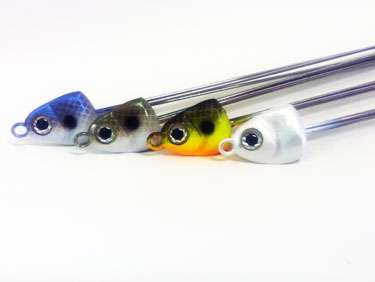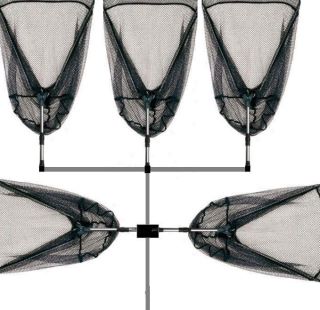
Demand for the Alabama rig is extraordinarily high right now and almost certainly higher than it will ever be again. At Andy Poss’ TheAlabamaRig.com, all of their items are listed as being “temporarily out of stock” and the backlog has been listed as five weeks for over a week. It’s obviously going to take them a while to catch up.
Meanwhile, on the “gray” market, Alabama rigs made by Poss’ company were selling on eBay for nearly $150 while homemade versions of the rig were going for about half that. As this story goes to post, the going rate on knock offs appears to be $30-40 … not bad for something most sellers are making in their garage for pennies on the dollar.
Luckily for anglers, there are commercial alternatives out there, and there will certainly be more very soon.
One alternative comes out of neighboring Georgia from Sworming Hornet Lures (SwormingHornetLures.com), perhaps best known for their Fish Head Spin lure. They call their castable umbrella rig “The Swarm.” More variations will certainly be on the way in the rising tide of all this excitement.
We can only guess at the future of Andy Poss’ company and his Alabama rig, but it’s a fact of life that the fishing industry is extremely predatory. You don’t have to attend many ICAST conventions before you realize that today’s innovative new product is tomorrow’s target for bigger companies with larger production systems and better distribution. Even for the little guy who makes a product that’s demonstrably “better,” it’s almost impossible to withstand the crush of new rigs that’s certainly coming … and fast.
Maybe Poss sells his patent (still pending) and his company to one of the giants, or maybe he weathers the storm and winds up on top. Either way, his devise is only a derivative of an earlier rig, not something truly new. The reality is that other manufacturers won’t have to change much to get around his patent, and a five week backlog is simply not going to work for a fishing public that wants the Alabama rig right now — not in five weeks when most bass anglers around the country will have traded their front deck pedestal for a recliner in front of the flat screen.
Industry Impact
It remains to be seen just how the Alabama rig will impact the sport of bass fishing and tournament fishing in particular. Its primary benefit seems to be for targeting suspended bass and offering them a presentation they haven’t seen before (unless they share water with striped bass and trollers who are already using umbrella rigs).
Of course, manufacturers of these castable umbrella rigs maintain they also work with five topwater baits or five of just about anything you can imagine. Let’s leave it to the angling community to quickly figure out how to use the rig and get the most out of it. Bass fishermen are a creative group, and it’s almost certain that someone will figure out a great way to use it that isn’t even on the horizon right now.
Personally, I’m waiting to see Gerald Swindle — the Elite Series’ premier “junk” fisherman — tie on an Alabama rig with a spinnerbait, a jerkbait, a shallow-running crankbait, a lipless crankbait and a topwater on it, all at once! Then, instead of keeping 10 rods on his deck, each with a different lure, he’ll only need two.
Or how about Kevin VanDam setting up his Alabama rig with five Strike King Red Eye Shads? If you thought he could cover water before, you ain’t seen nothin’ yet!
 And we haven’t even talked about how the rig might impact other aspects of the industry. Ever wondered what a net for the Alabama rig might look like? Luckily, a bass angler with some Photoshop skills has already figured it out.
And we haven’t even talked about how the rig might impact other aspects of the industry. Ever wondered what a net for the Alabama rig might look like? Luckily, a bass angler with some Photoshop skills has already figured it out.
The Slippery Slope
Whatever the future of the Alabama rig, one debate for right now concerns the morality and “proper” use of the rig. Just as many anglers are excited about the potential ways they can fish it, others maintain it should be banned altogether, restricted from tournament use or that it’s somehow “unfair” to the fish and removes challenge from the sport.
The first issue, banning it, will be handled on a state-by-state or even water-by-water basis as state and local agencies assess the perceived threats posed by the rigs. Similarly, its use in tournaments will be decided by the various circuits around the country and world, though it should be noted that other rigs offering more than one lure to the fish have been permitted for generations. The double-fluke rig, drop shot/shakey head combo and variations on the old Norman Front Runner come immediately to mind.
As for those who believe the umbrella rig is somehow unsportsmanlike, you should know that the same argument has been made for side-imaging, GPS, sonar and even the plastic worm. When these tools were introduced, a segment of the public clamored that they be outlawed because they were so effective, so destructive and so easy to use and catch fish that the bass couldn’t possibly withstand their widespread use.
The bottom line is that the Alabama rig is a tool and a small piece in a very large puzzle. It won’t catch even one bass unless an angler puts it in front of one with the right bait attached and retrieved at the proper speed.
Eventually, the hype and hoopla surrounding the Alabama rig will die down, just as it did for the Heddon River Runt, the Creme Wiggle Worm, the Rapala floating minnow, the Big-O, the Lunker Lure buzzbait, the Carolina rig, the Zoom Fluke, the Yamamoto Senko and legions of other baits and rigs that may have lost some of their luster but retain a place in the sport and our tackleboxes.
And lest you fear that the Alabama rig will seine our waters of bass and turn them into a watery wasteland, look to the heavens.
You’ll see that the sky isn’t falling.





